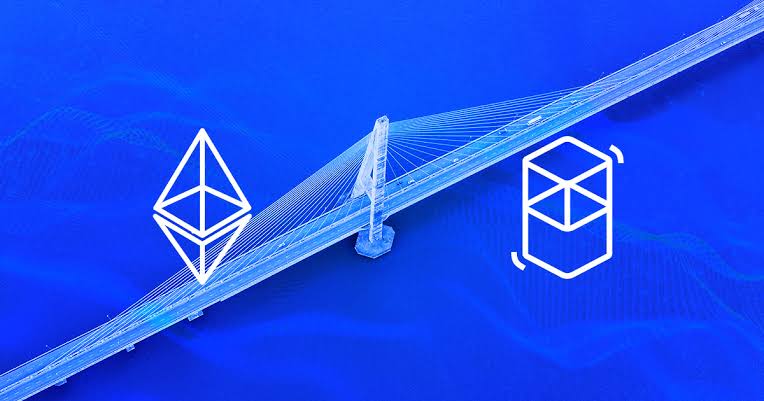Blockchain technology has ushered in a new era of decentralization, disrupting various industries and offering innovative solutions to long-standing challenges. As the adoption of blockchain networks continues to grow, developers and enthusiasts have realized the need for seamless communication and interoperability between these individual islands of decentralization. This is where blockchain bridges come into play. In this article, we will explore what blockchain bridges are and delve into an example, the PiBridge from Pi Network, to understand their significance in the world of decentralized systems.
What are Blockchain Bridges?
Imagine the blockchain ecosystem as a vast archipelago, with each island representing an independent blockchain network. Each blockchain, whether it’s Bitcoin, Ethereum, or any other cryptocurrency, functions on its own, maintaining its ledger and governing rules. However, these isolated networks can often create limitations, such as restricting data flow and inhibiting the exchange of assets between them. Blockchain bridges, also known as cross-chain bridges or interoperability protocols, act as connective channels between these isolated networks, enabling seamless communication and interaction.
In essence, blockchain bridges function as gateways that facilitate the transfer of digital assets, data, and information between different blockchains. They serve as crucial infrastructure to expand the utility of decentralized systems, fostering innovation and collaboration between diverse projects and communities.
Understanding PiBridge
One notable example of a blockchain bridge is the PiBridge developed by Pi Network. Pi Network gained traction as a project focused on creating a user-friendly cryptocurrency mining platform that could be accessed through mobile devices. However, unlike traditional cryptocurrencies that rely on energy-intensive Proof-of-Work (PoW) mechanisms, Pi Network opted for a more energy-efficient consensus algorithm known as Proof-of-Work-Stake (PoW/PoS).
As Pi Network grew in popularity, its developers recognized the importance of expanding its utility and creating bridges to other blockchains. This led to the creation of PiBridge, a feature designed to connect Pi Network’s native blockchain with other major blockchain networks, such as Ethereum, Binance Smart Chain, and more.
The Significance of PiBridge and Similar Solutions
1. Interoperability: PiBridge addresses one of the fundamental challenges in the blockchain space – interoperability. By connecting to other blockchains, Pi Network participants can access a broader range of decentralized applications (DApps), swap assets across different networks, and leverage the strengths of multiple platforms.
2. Asset Portability: With PiBridge, users can move their assets between Pi Network’s native blockchain and other supported networks. This feature enhances flexibility and ensures that users can access the benefits of various ecosystems without being restricted to a single network’s limitations.
3. Scalability and Efficiency: As the blockchain industry expands, scalability remains a crucial concern. PiBridge and similar interoperability protocols help distribute the load of network activities across multiple blockchains, reducing congestion and enhancing overall efficiency.
4. Fostering Collaboration: By creating bridges between blockchains, projects like Pi Network encourage collaboration between different communities and development teams. This cross-pollination of ideas can lead to innovative solutions and accelerate the growth of the entire decentralized ecosystem.

Blockchain bridges, exemplified by PiBridge in the case of Pi Network, represent a crucial step forward in the evolution of blockchain technology. They break down barriers between isolated networks, enabling seamless communication and the transfer of assets, data, and information. With increasing adoption and the continued development of interoperability solutions, the blockchain ecosystem moves closer to realizing its full potential. As the industry advances, we can expect even more sophisticated and robust blockchain bridges to facilitate a truly interconnected and decentralized future.
The Road Ahead: Advancing Blockchain Interoperability
As the blockchain space continues to mature, the development of more advanced and efficient blockchain bridges is inevitable. Several projects are already actively working on creating sophisticated interoperability solutions to overcome the challenges posed by the diverse blockchain landscape. Here are some directions in which the evolution of blockchain bridges is expected to progress:
1. Enhanced Security Measures: Security is a top priority when it comes to blockchain bridges. As these bridges facilitate the transfer of assets and data between different networks, it is essential to ensure robust security measures to prevent potential vulnerabilities and attacks. Future blockchain bridges are likely to incorporate advanced cryptographic techniques and consensus mechanisms to maintain the integrity and privacy of transactions.
2. Cross-Chain Smart Contracts: Smart contracts are a cornerstone of blockchain technology, enabling self-executing agreements without the need for intermediaries. The next generation of blockchain bridges is expected to support cross-chain smart contracts, allowing them to be executed across multiple blockchains. This capability will open up endless possibilities for decentralized applications and automated processes that span different networks.
3. Standardization and Interoperability Protocols: As more blockchain bridges emerge, the need for standardization becomes crucial. Standard protocols and interfaces will enable seamless communication between various bridges and networks, promoting a unified ecosystem. Projects and developers will collaborate to define industry-wide interoperability standards to ensure smoother cross-chain interactions.
4. Decentralized Oracles: Decentralized oracles are data feeds that provide external information to smart contracts. They play a vital role in enabling blockchain networks to access real-world data. Future blockchain bridges are likely to incorporate decentralized oracles to securely interact with data outside their native networks. This will enhance the functionality of cross-chain smart contracts and decentralized applications that rely on external data.
5. Cross-Chain Governance: As blockchain networks become interconnected, cross-chain governance mechanisms will be necessary to address decision-making processes that affect multiple networks. This involves ensuring consensus among different communities and networks while maintaining decentralized principles. Cross-chain governance will be essential in resolving disputes and coordinating network upgrades that impact interconnected blockchains.
6. Layer 2 Solutions and Scalability: To ensure the scalability and efficiency of cross-chain transactions, blockchain bridges may integrate with Layer 2 solutions. Layer 2 protocols, such as state channels and sidechains, can process a high volume of transactions off-chain, reducing the burden on the main blockchain. Integrating Layer 2 solutions with blockchain bridges will improve the overall performance and user experience of cross-chain interactions.
Blockchain bridges are a crucial development in the journey towards a more interconnected and efficient blockchain ecosystem. They enable seamless communication, asset transfer, and data sharing between isolated blockchain networks, promoting collaboration and innovation in the decentralized space. The example of PiBridge from Pi Network showcases the practical application and potential impact of such interoperability solutions.
As blockchain technology continues to evolve, the advancement of blockchain bridges will play a pivotal role in driving mass adoption and achieving the true potential of decentralization. Developers, researchers, and enthusiasts alike will continue to work towards enhancing the security, scalability, and functionality of these bridges, fostering an interconnected and decentralized future that empowers users worldwide. Embracing blockchain bridges and interoperability will create a more inclusive and vibrant blockchain landscape, propelling the industry towards new heights of innovation and global impact.
Follow us for more updates on Twitter












